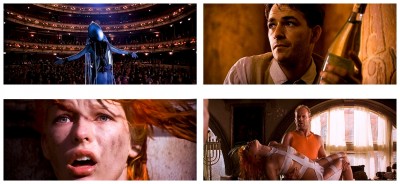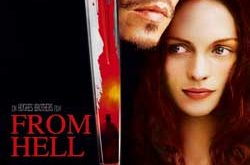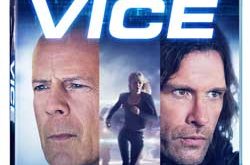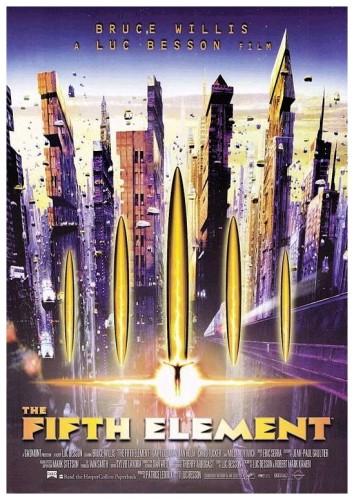 SYNOPSIS:
SYNOPSIS:
“In the twenty-third century, the universe is threatened by evil. The only hope for mankind is the Fifth Element, who comes to Earth every five thousand years to protect the humans with four stones of the four elements: fire, water, earth and air. A Mondoshawan spacecraft is bringing the fifth element back to Earth but it is destroyed by the evil Mangalores. However, a team of scientists use the DNA of the remains of the fifth element to rebuild the perfect being called Leeloo. She escapes from the laboratory and stumbles upon the taxi driver and former elite commando major Korben Dallas that helps her to escape from the police. Leeloo tells him that she must meet Father Vito Cornelius to accomplish her mission. Meanwhile, the Evil uses the greedy and cruel Jean-Baptiste Emanuel Zorg and a team of mercenary Mangalores to retrieve the stones and avoid the protection of Leeloo. But the skilled Korben Dallas has fallen in love with Leeloo and decides to help her to retrieve the stones.” (courtesy IMDB)
REVIEW:
Filmmaking was Luc Besson‘s second career choice – he really wanted to be a deep-sea diver. His parents were diving instructors around the Mediterranean, and the young Besson would follow his father from resort to resort, deep-sea diving, wasting time, living in his imagination. When he was ten years old, in 1969, he had an undersea encounter with a dolphin which convinced him he wanted to study the sea and its ecology. Seven years later he had an accident while diving, and doctors said he could never dive again. Besson dropped out of school and began experimenting with a Super-8 camera, trying to find a way into the French film industry. After a three-month stay in Hollywood, he began to get work as an assistant director, and a half-dozen years later he won a César nomination and several other awards for his own first feature The Final Combat (1983), which I reviewed for Horror News only a couple of months ago. His next film Subway (1985), concerning surreal new-wave adventures in the Paris Metro underground railway, secured a few more César nominations and became a midnight cult favourite, soon followed by The Big Blue (1988) and Nikita (1990).
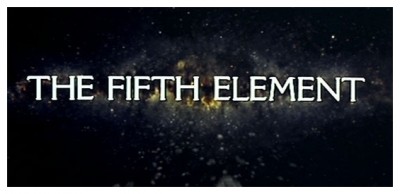 The movies shared deliberately sketchy characters and a tone of amused detachment. Nikita made Besson’s name in the USA and gave a starring role to his then-girlfriend Anne Parillaud, but their love affair fell apart soon afterwards, driving Besson deeper into his films, by which time he had become France’s most successful director. When Nikita was clumsily remade as Point Of No Return (1993) by John Badham starring Bridget Fonda, it only threw his distinctive style into sharp relief. His films were hip, stylish, potent, and he got more out of oddballs like Jean Reno and Christopher Lambert than most directors could. None of which was really a good enough reason to give him a budget of US$90 million and allow him to indulge the biggest space fantasy ever produced outside America. After completing Nikita it took him five years to get The Fifth Element under way, so long that he turned away from its widescreen gigantism altogether and made Leon The Professional (1994) instead. This was his other low-key New York movie in which a lonely contract killer (Jean Reno) protects a precocious orphan girl (Natalie Portman). The violence and dangerous sexual undercurrent of the movie was just another step towards one of the biggest science fiction blockbusters of the nineties.
The movies shared deliberately sketchy characters and a tone of amused detachment. Nikita made Besson’s name in the USA and gave a starring role to his then-girlfriend Anne Parillaud, but their love affair fell apart soon afterwards, driving Besson deeper into his films, by which time he had become France’s most successful director. When Nikita was clumsily remade as Point Of No Return (1993) by John Badham starring Bridget Fonda, it only threw his distinctive style into sharp relief. His films were hip, stylish, potent, and he got more out of oddballs like Jean Reno and Christopher Lambert than most directors could. None of which was really a good enough reason to give him a budget of US$90 million and allow him to indulge the biggest space fantasy ever produced outside America. After completing Nikita it took him five years to get The Fifth Element under way, so long that he turned away from its widescreen gigantism altogether and made Leon The Professional (1994) instead. This was his other low-key New York movie in which a lonely contract killer (Jean Reno) protects a precocious orphan girl (Natalie Portman). The violence and dangerous sexual undercurrent of the movie was just another step towards one of the biggest science fiction blockbusters of the nineties.
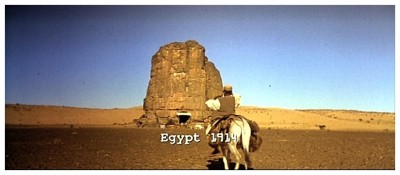 Although The Fifth Element (1997) was shrouded in mystery during production, initial reports indicated that it had become a blockbuster gone mad. Effects-laden to the tune of ninety million, the most expensive French-financed film ever, it had no easily digestible ‘hook’. The trailers simply made non-committal statements like “It Must Be Found!” and “What Is The Fifth Element?” but a ninety million dollar movie needs a single ninety million dollar idea, right? The film’s nominal star Bruce Willis was at the time best known for his Die Hard (1988) franchise and a supporting cast consisting of the relatively unknown Milla Jovovich, the fatherly Ian Holm and a wild-eyed loose cannon played by Gary Oldman, all seemed to be calculated to make this the most expensive art-house movie ever. A French director, an out-of-control budget and the presence of Willis made it look more like a doomed ‘star vehicle’ instead of a science fiction epic. Its design took inspiration from avant-garde French comic artist Jean ‘Moebius’ Giraud with costumes by Jean-Paul Gautier, so its got ‘fashion’ in it too, possibly the ultimate turn-off for the hot-dog-chomping mainstream audiences whose fun-buttons every blockbuster must press.
Although The Fifth Element (1997) was shrouded in mystery during production, initial reports indicated that it had become a blockbuster gone mad. Effects-laden to the tune of ninety million, the most expensive French-financed film ever, it had no easily digestible ‘hook’. The trailers simply made non-committal statements like “It Must Be Found!” and “What Is The Fifth Element?” but a ninety million dollar movie needs a single ninety million dollar idea, right? The film’s nominal star Bruce Willis was at the time best known for his Die Hard (1988) franchise and a supporting cast consisting of the relatively unknown Milla Jovovich, the fatherly Ian Holm and a wild-eyed loose cannon played by Gary Oldman, all seemed to be calculated to make this the most expensive art-house movie ever. A French director, an out-of-control budget and the presence of Willis made it look more like a doomed ‘star vehicle’ instead of a science fiction epic. Its design took inspiration from avant-garde French comic artist Jean ‘Moebius’ Giraud with costumes by Jean-Paul Gautier, so its got ‘fashion’ in it too, possibly the ultimate turn-off for the hot-dog-chomping mainstream audiences whose fun-buttons every blockbuster must press.
 The reason why there was no single-issue high-concept sell is now obvious. The Fifth Element is really ten movies squished into one – a philosophical-art-house-sci-fi-action-comedy-romance-epic held together by sharp funny European sensibilities. The story is simplicity itself: In the year 2263, the Earth is in danger of being destroyed by a gigantic molten ball of lava. In a colourful flamboyant future with weird aliens and cosmic weapons, it should come as no surprise that the salvation of mankind rests upon the shoulders of a motley crew of characters consisting of mercenary-soldier-turned-taxi-driver Korben Dallas (Bruce Willis), new-age priest Vito Cornelius (Ian Holm) and an outspoken radio host named Ruby Rhod (Chris Tucker). The Fifth Element is not some sort of doomsday device but a beautiful humanoid girl named Leeloo (Milla Jovovich) with enhanced DNA, orange hair and a voice like Björk, while Jean-Baptiste Emanuel Zorg (Gary Oldman) is a Texan arms dealer with a Hitler haircut who wants to kill her, and love saves the day on several occasions.
The reason why there was no single-issue high-concept sell is now obvious. The Fifth Element is really ten movies squished into one – a philosophical-art-house-sci-fi-action-comedy-romance-epic held together by sharp funny European sensibilities. The story is simplicity itself: In the year 2263, the Earth is in danger of being destroyed by a gigantic molten ball of lava. In a colourful flamboyant future with weird aliens and cosmic weapons, it should come as no surprise that the salvation of mankind rests upon the shoulders of a motley crew of characters consisting of mercenary-soldier-turned-taxi-driver Korben Dallas (Bruce Willis), new-age priest Vito Cornelius (Ian Holm) and an outspoken radio host named Ruby Rhod (Chris Tucker). The Fifth Element is not some sort of doomsday device but a beautiful humanoid girl named Leeloo (Milla Jovovich) with enhanced DNA, orange hair and a voice like Björk, while Jean-Baptiste Emanuel Zorg (Gary Oldman) is a Texan arms dealer with a Hitler haircut who wants to kill her, and love saves the day on several occasions.
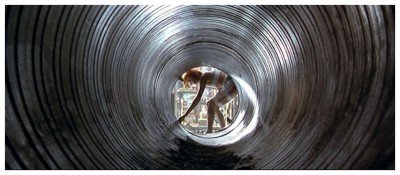 At the centre of the film is the eternal struggle between Good and Evil. Set within the context of a prophecy that the ‘Great Evil’ will arrive every five thousand years, Evil presents itself in the form of a large fireball that will engulf the Earth. Cornelius insists that the only weapon that can overcome Evil is the fifth element but, unlike the other four elements (earth, air, fire, water) the fifth element is a ‘perfect being’ named Leeloo, who is brought to Earth by the Mondoshawans, a friendly alien race who aim to help humanity. Afraid in this strange new world, Leeloo runs away from the scientists wishing to evaluate her, and runs into the arms of Korben Dallas. Memorable for his no-nonsense attitude and bright orange tank-top, Dallas falls in love with Leeloo. As they are chased by Zorg, multi-billionaire and supporter of the Great Evil, Dallas takes Leeloo on an intergalactic adventure to help her save humanity. As far as budget blowouts are concerned, it’s still pretty cool. This is a portmanteau myth, a modern composite with enough resonances to make it seem eternal, not unlike like Star Wars A New Hope (1977). Besson uses it to take us into the past, the future, outer space, and into the depths of what makes humans tick. There’s also New York and the screaming streets of Manhattan which seem to stretch off into infinity, not just horizontally but vertically.
At the centre of the film is the eternal struggle between Good and Evil. Set within the context of a prophecy that the ‘Great Evil’ will arrive every five thousand years, Evil presents itself in the form of a large fireball that will engulf the Earth. Cornelius insists that the only weapon that can overcome Evil is the fifth element but, unlike the other four elements (earth, air, fire, water) the fifth element is a ‘perfect being’ named Leeloo, who is brought to Earth by the Mondoshawans, a friendly alien race who aim to help humanity. Afraid in this strange new world, Leeloo runs away from the scientists wishing to evaluate her, and runs into the arms of Korben Dallas. Memorable for his no-nonsense attitude and bright orange tank-top, Dallas falls in love with Leeloo. As they are chased by Zorg, multi-billionaire and supporter of the Great Evil, Dallas takes Leeloo on an intergalactic adventure to help her save humanity. As far as budget blowouts are concerned, it’s still pretty cool. This is a portmanteau myth, a modern composite with enough resonances to make it seem eternal, not unlike like Star Wars A New Hope (1977). Besson uses it to take us into the past, the future, outer space, and into the depths of what makes humans tick. There’s also New York and the screaming streets of Manhattan which seem to stretch off into infinity, not just horizontally but vertically.
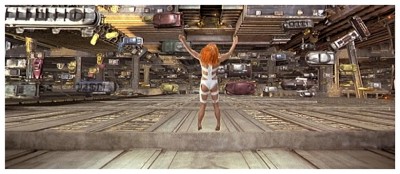 The Fifth Element is Besson’s grand tour of the universe, and it makes the twin towers of modern science fiction – Star Wars and Blade Runner (1982) – look rather anaemic and humourless by comparison. According to special effects supervisor Mark Stetson: “The look of the city was one of the key ways we used to convey a little of The Fifth Element’s backstory, if moviegoers are looking for it. The basic premise of the world the movie takes place in, is that in the 23rd century, mankind is still a working society, kind of creaky and not too different from today, but it has moved out into the planets. Lightspeed travel has been achieved and we’ve gone on to colonise other worlds by terraforming them. We’ve harvested water from the Earth and taken it out to use on other planets. So the sea levels on Earth have fallen and, rather than keep building upwards, man has started tunneling down, excavating space out of the Earth. That’s why, when Leeloo looks downwards for the first time, New York is as infinite as it is when she’s looking upwards or horizontally. The look and the story are all coherent. The reason New York looks the way it does, and the fact that the human race is in space, are intrinsically linked. Old Manhattan, the Williamsburg Bridge and the Statue Of Liberty haven’t been raised up on pedestals, they’re where they’ve always been. The sea has fallen instead, and we say that all in a couple of shots.”
The Fifth Element is Besson’s grand tour of the universe, and it makes the twin towers of modern science fiction – Star Wars and Blade Runner (1982) – look rather anaemic and humourless by comparison. According to special effects supervisor Mark Stetson: “The look of the city was one of the key ways we used to convey a little of The Fifth Element’s backstory, if moviegoers are looking for it. The basic premise of the world the movie takes place in, is that in the 23rd century, mankind is still a working society, kind of creaky and not too different from today, but it has moved out into the planets. Lightspeed travel has been achieved and we’ve gone on to colonise other worlds by terraforming them. We’ve harvested water from the Earth and taken it out to use on other planets. So the sea levels on Earth have fallen and, rather than keep building upwards, man has started tunneling down, excavating space out of the Earth. That’s why, when Leeloo looks downwards for the first time, New York is as infinite as it is when she’s looking upwards or horizontally. The look and the story are all coherent. The reason New York looks the way it does, and the fact that the human race is in space, are intrinsically linked. Old Manhattan, the Williamsburg Bridge and the Statue Of Liberty haven’t been raised up on pedestals, they’re where they’ve always been. The sea has fallen instead, and we say that all in a couple of shots.”
 At the press conference directly after the premiere of The Fifth Element, Besson stated: “The first step of the story comes when I was sixteen, living in France, the country of cheese. I am very bored, so I take my pen and I create this world. I take a lot of pleasure to invent the system so, even when I have the hero living in an apartment in New York, I ask myself, why does he rent it? Why not buy? I have it down even to these details. I organise the society and I write the future ten years at a time, so when I come to write the real story, it is ready. The actual story of The Fifth Element only comes about five years ago. I have lived a little more and life has given me some smacks. I have seen more, it gives you the skin of a crocodile, so now I want to make a movie that says, why save life when you see what we do with it?” It all seems so simple: There’s no ‘ninety-million-dollar-idea’ as such, but ninety one-million-dollar ideas instead, cramming the screen with invention, thrills and humour, a virtual Ben-Hur (1959) in space, a blockbuster with both a brain and heart. Maybe it’s because Hollywood had driven apart the notions of art and blockbuster success so efficiently that you couldn’t imagine an American filmmaker seriously entertaining such an idea, certainly not during a time when Hollywood directors like Joel Schumacher commanded big budgets for their self-proclaimed ‘wild rides’.
At the press conference directly after the premiere of The Fifth Element, Besson stated: “The first step of the story comes when I was sixteen, living in France, the country of cheese. I am very bored, so I take my pen and I create this world. I take a lot of pleasure to invent the system so, even when I have the hero living in an apartment in New York, I ask myself, why does he rent it? Why not buy? I have it down even to these details. I organise the society and I write the future ten years at a time, so when I come to write the real story, it is ready. The actual story of The Fifth Element only comes about five years ago. I have lived a little more and life has given me some smacks. I have seen more, it gives you the skin of a crocodile, so now I want to make a movie that says, why save life when you see what we do with it?” It all seems so simple: There’s no ‘ninety-million-dollar-idea’ as such, but ninety one-million-dollar ideas instead, cramming the screen with invention, thrills and humour, a virtual Ben-Hur (1959) in space, a blockbuster with both a brain and heart. Maybe it’s because Hollywood had driven apart the notions of art and blockbuster success so efficiently that you couldn’t imagine an American filmmaker seriously entertaining such an idea, certainly not during a time when Hollywood directors like Joel Schumacher commanded big budgets for their self-proclaimed ‘wild rides’.
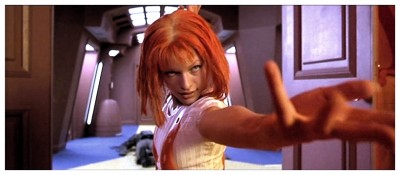 The Fifth Element‘s combination of hyper-reality and grit summons Blade Runner to mind, and we all remember how that did at the box-office when it was first released. “The big difference between this and Blade Runner is that Blade Runner is at night with smoke and rain and darkness. It’s hard for the audience. This is noon, you don’t see one car, you see four hundred, you can see everything!” Though the film is now perhaps best-known for its design and cinematography, one should not let these appearances overshadow the film’s presentation of the picture of Good and Evil in the human condition. This picture is personified through the human characters and their endeavours toward creation and destruction. Cornelius represents that which is good, as his goal is to create a world of peace, whereas Zorg epitomises evil in his quest to destroy life: “By creating a little destruction, I’m actually encouraging life – you and I are in the same business!” While these two characters show the apparent extremes of Good and Evil, Leeloo wonders why she should even bother saving the human race, as she begins to believe that, collectively, Earthlings may be more Evil than Good, and could end up destroying each other. However, through Dallas’s love, she is convinced that one should be optimistic and have hope that the human race can overcome the evil in themselves and become better beings.
The Fifth Element‘s combination of hyper-reality and grit summons Blade Runner to mind, and we all remember how that did at the box-office when it was first released. “The big difference between this and Blade Runner is that Blade Runner is at night with smoke and rain and darkness. It’s hard for the audience. This is noon, you don’t see one car, you see four hundred, you can see everything!” Though the film is now perhaps best-known for its design and cinematography, one should not let these appearances overshadow the film’s presentation of the picture of Good and Evil in the human condition. This picture is personified through the human characters and their endeavours toward creation and destruction. Cornelius represents that which is good, as his goal is to create a world of peace, whereas Zorg epitomises evil in his quest to destroy life: “By creating a little destruction, I’m actually encouraging life – you and I are in the same business!” While these two characters show the apparent extremes of Good and Evil, Leeloo wonders why she should even bother saving the human race, as she begins to believe that, collectively, Earthlings may be more Evil than Good, and could end up destroying each other. However, through Dallas’s love, she is convinced that one should be optimistic and have hope that the human race can overcome the evil in themselves and become better beings.
 The film polarised critics on its initial release, and mixed opinion continues to this day. Some critics describe it as a cult classic while others exclaim that Besson should stay away from science fiction altogether. In fact Mark Kermode stated that The Fifth Element was one of the most divisive films among his readers, regarded as both the best and worst blockbuster of all time: “I remember very clearly being in Cannes when The Fifth Element was first played, and it really divided the audience!” Kevin Thomas: “An elaborate, even campy sci-fi extravaganza, which is nearly as hard to follow as last year’s Mission Impossible (1996), a lot warmer, more fun and boasts some of the most sophisticated, witty production and costume design you could ever hope to see.” Roger Ebert: “One of the great goofy movies. I would not have missed seeing this film, and I recommend it for its richness of imagery but, at 127 minutes, which seems a reasonable length, it plays long.”
The film polarised critics on its initial release, and mixed opinion continues to this day. Some critics describe it as a cult classic while others exclaim that Besson should stay away from science fiction altogether. In fact Mark Kermode stated that The Fifth Element was one of the most divisive films among his readers, regarded as both the best and worst blockbuster of all time: “I remember very clearly being in Cannes when The Fifth Element was first played, and it really divided the audience!” Kevin Thomas: “An elaborate, even campy sci-fi extravaganza, which is nearly as hard to follow as last year’s Mission Impossible (1996), a lot warmer, more fun and boasts some of the most sophisticated, witty production and costume design you could ever hope to see.” Roger Ebert: “One of the great goofy movies. I would not have missed seeing this film, and I recommend it for its richness of imagery but, at 127 minutes, which seems a reasonable length, it plays long.”
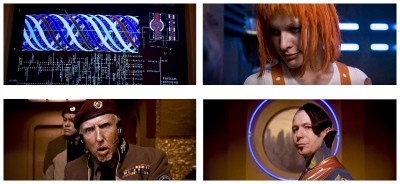 Not everyone was so pleased with Besson’s homage to the Metal Hurlant/Heavy Metal comics of his youth. Cult filmmaker Alejandro Jodorowsky and artist Jean ‘Moebius’ Giraud sued Besson well after the film was released, claiming The Fifth Element had stolen ideas from their comic series The Incal. Giraud sued for 22 million euros plus five percent of the revenue, and Jodorowsky sued for a mere 700,000 euros, but their case was apparently laughed out of court because Giraud had been originally hired to work on the film, and only tiny fragments of Giraud’s artwork had been utilised. There were rumours reported of a possible follow-up movie tentatively titled Mister Shadow in development, but Besson stated quite clearly in a 2011 interview that no sequel was ever planned, and he has absolutely no desire to make one, possibly due to the legal hassles the first film caused. I’ll allow you to ponder the litigious bear-traps to be found lurking around the film industry for the next seven days, as I eagerly anticipate having your company again next week when I discuss another glorious piece of filmic fluff for Horror News. I’m sure there’s much suspense waiting to see if the film I choose will amuse, bewilder, antagonise or enchant – until then, toodles!
Not everyone was so pleased with Besson’s homage to the Metal Hurlant/Heavy Metal comics of his youth. Cult filmmaker Alejandro Jodorowsky and artist Jean ‘Moebius’ Giraud sued Besson well after the film was released, claiming The Fifth Element had stolen ideas from their comic series The Incal. Giraud sued for 22 million euros plus five percent of the revenue, and Jodorowsky sued for a mere 700,000 euros, but their case was apparently laughed out of court because Giraud had been originally hired to work on the film, and only tiny fragments of Giraud’s artwork had been utilised. There were rumours reported of a possible follow-up movie tentatively titled Mister Shadow in development, but Besson stated quite clearly in a 2011 interview that no sequel was ever planned, and he has absolutely no desire to make one, possibly due to the legal hassles the first film caused. I’ll allow you to ponder the litigious bear-traps to be found lurking around the film industry for the next seven days, as I eagerly anticipate having your company again next week when I discuss another glorious piece of filmic fluff for Horror News. I’m sure there’s much suspense waiting to see if the film I choose will amuse, bewilder, antagonise or enchant – until then, toodles!
 Horror News | HNN Official Site | Horror Movies,Trailers, Reviews
Horror News | HNN Official Site | Horror Movies,Trailers, Reviews
